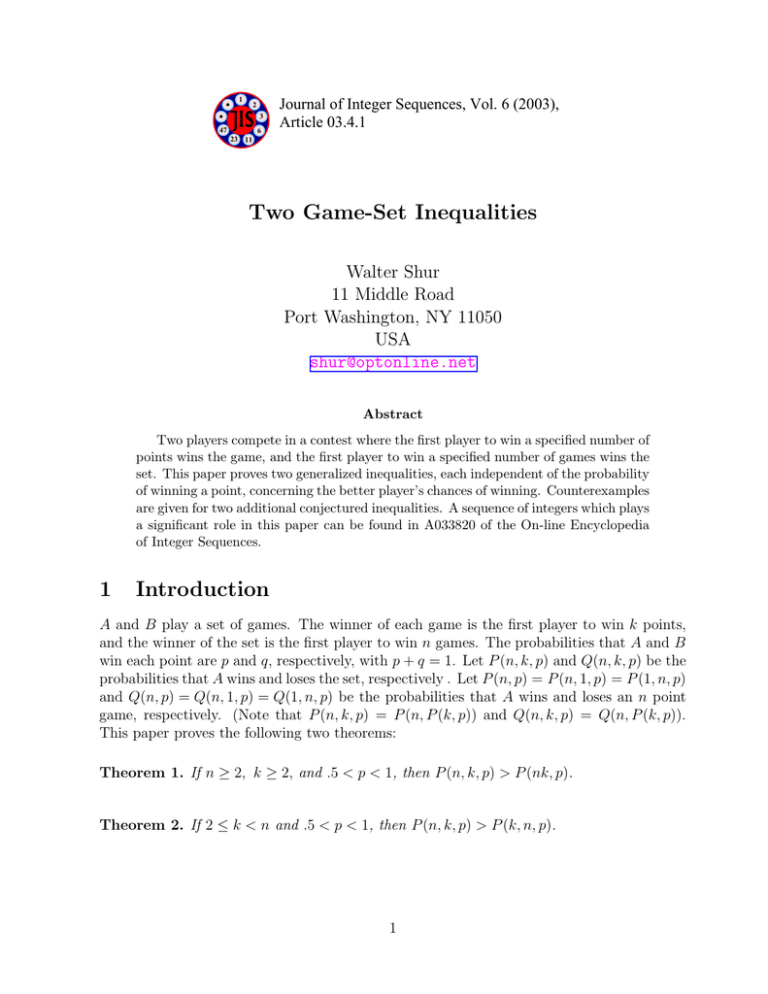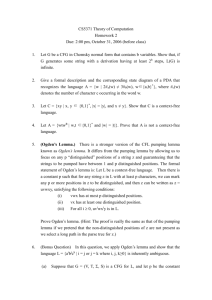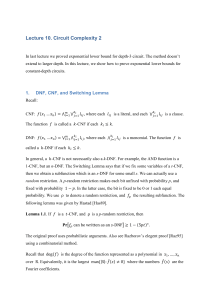Two Game-Set Inequalities Walter Shur 11 Middle Road Port Washington, NY 11050
advertisement

1
2
3
47
6
Journal of Integer Sequences, Vol. 6 (2003),
Article 03.4.1
23 11
Two Game-Set Inequalities
Walter Shur
11 Middle Road
Port Washington, NY 11050
USA
shur@optonline.net
Abstract
Two players compete in a contest where the first player to win a specified number of
points wins the game, and the first player to win a specified number of games wins the
set. This paper proves two generalized inequalities, each independent of the probability
of winning a point, concerning the better player’s chances of winning. Counterexamples
are given for two additional conjectured inequalities. A sequence of integers which plays
a significant role in this paper can be found in A033820 of the On-line Encyclopedia
of Integer Sequences.
1
Introduction
A and B play a set of games. The winner of each game is the first player to win k points,
and the winner of the set is the first player to win n games. The probabilities that A and B
win each point are p and q, respectively, with p + q = 1. Let P (n, k, p) and Q(n, k, p) be the
probabilities that A wins and loses the set, respectively . Let P (n, p) = P (n, 1, p) = P (1, n, p)
and Q(n, p) = Q(n, 1, p) = Q(1, n, p) be the probabilities that A wins and loses an n point
game, respectively. (Note that P (n, k, p) = P (n, P (k, p)) and Q(n, k, p) = Q(n, P (k, p)).
This paper proves the following two theorems:
Theorem 1. If n ≥ 2, k ≥ 2, and .5 < p < 1, then P (n, k, p) > P (nk, p).
Theorem 2. If 2 ≤ k < n and .5 < p < 1, then P (n, k, p) > P (k, n, p).
1
2
Proofs
Lemma 1. P (k, p) =
1
2
+
1
(p
2
k−1 µ ¶
X
2i
− q)
(pq)i .
i
i=0
Proof. We show first that
µ ¶
2k
1
(pq)k , k ≥ 1.
P (k + 1, p) − P (k, p) = (p − q)
k
2
(1)
The only (k + 1)-point games in which the winner might be different than the winner of
the k-point game are those which are tied at k points each.
The increase in A’s chance of winning a k + 1-point game over his chance of winning a
k-point game is the excess of (a) the probability that there is a k-point tie, B having won
the k-point game, and A wins the next point, over (b) the probability that there is a k-point
tie, A having won the k-point game, and B wins the next point. Note that in half of those
B won the k-point game, and in the other half, A won the k-point game. Since
¢ games,
¡tied
2k
k
(pq)
is
the
probability of a k-point tie, (1) holds.
k
Lemma 1 is true since it is true for k = 1, and its right hand side simply sums the
differences in (1).
Lemma 2. Let ak,i
µ ¶µ ¶
k−1
X
1 2k
2i
k
. Then P (k, p)Q(k, p) = (pq)k
:=
ak,i (pq)i ,
2 k
i k+i
i=0
(Note that ak,i is equal to ak+i−1,k−1 in A033820 of the On-line Encyclopedia of Integer
Sequences.)
Proof. We see from Lemma 1, noting that −(p − q)2 = 4pq − 1, that
Since
!2
à k−1 µ ¶
X 2i
1 1
i
.
(pq)
P (k, p)Q(k, p) = + (4pq − 1)
4 4
i
i=0
Ã
∞ µ ¶
X
2i
i=0
i
(pq)
i
!2
=
µ
1
√
1 − 4pq
¶2
t
=
∞
X
(2)
4i (pq)i ,
i=0
we see that if 1 ≤ t ≤ k − 1, the coefficient of (pq) in (2) equals
equals 0 for t = 0 as well.
1
4
· 4 · 4t−1 − 14 · 4t = 0, and
Hence, we can define ak,i such that
P (k, p)Q(k, p) = (pq)
k
k−1
X
i=0
Thus, ak,t−k is the coefficient of (pq)t in (2).
2
ak,i (pq)i .
(3)
We have, then
ak,t−k
¶
¶
µ ¶µ
k−1 µ ¶µ
k−1
X
1 X
2t − 2j − 2
2t − 2j
2j
2j
−
=
t
−
j
−
1
t−j
4 j=t−k+1 j
j
j=t−k
=
µ
2t − 2k
t−k
µ ¶ µµ
¶
¶µ
¶
µ
¶¶
k−1
X
2j
2t − 2j − 2
2k − 2
1 2t − 2j
−
+
j
t−j−1
k−1
4 t−j
j=t−k+1
=
µ
2t − 2k
t−k
µ ¶µ
¶
¶µ
¶
k−1
2j
2t − 2j − 2
1
2k − 2
1 X
.
+
t−j−1 t−j
k−1
2 j=t−k+1 j
Let g(t, j) =
j(2t − 2j − 1)
¡2j ¢¡2t−2j−2¢
j
t−j−1
(t − j)t
We show that
(4)
.
µ ¶µ
¶
2j
2t − 2j − 2
1
= g(t, j + 1) − g(t, j)
j
t−j−1 t−j
¢
¡ ¢¡
to obtain
by dividing both sides of the equation by 2jj 2t−2j−2
t−j−1
(5)
1
1 + 2j j(2t − 2j − 1)
1
=
−
=
.
t−j
t
(t − j)t
t−j
Let S(t, k) equal the sum in (4). By summing both sides of (5) from j = t − k + 1 to
k − 1, we see that S(t, k) is equal to g(t, k) − g(t, t − k + 1), and we have
¢¡2k−4¢
¡
¡ ¢¡2t−2k−2¢
(t − k + 1)(2k − 3) 2t−2k+2
k(2t − 2k − 1) 2k
k−2
t−k−1
t−k+1
k
−
.
S(t, k) =
(t − k)t
(k − 1)t
We see from (4) that
ak,t−k =
Dividing both sides by
¡2k¢¡2t−2k¢
k
t−k
ak,t−k
¡2k¢¡2t−2k¢ =
k
t−k
µ
2t − 2k
t−k
¶µ
¶
1
2k − 2
+ S(t, k).
k−1
2
, we have
1
k
+
4k − 2 2
µ
k(2t − 2k + 1)
k
−
2t
2(2k − 1)t
Replacing t by k + i gives
ak,i
µ ¶µ ¶
k
2i
1 2k
=
.
i k+i
2 k
3
¶
=
k
.
2t
Lemma 3.
µ ¶
1 2k
(pq)k−1 , where the derivative is taken with respect to p.
P (k, p) = k
k
2
0
Proof. The probability that A wins a k-point game on the (k + i)th point played is
¶
µ
k k−1+i
(1 − p)i .
p
i
Hence,
P (k, p) = pk
¶
k−1 µ
X
k−1+i
i=0
i
(1 − p)i = pk
k−1
X
(−1)j
j=0
à k−1 µ ¶µ
¶!
X i
k−1+i
i=j
j
i
pj .
We have
¶
k−1 µ ¶µ
X
i
k−1+i
i=j
j
i
=
¶µ
¶
k−1 µ
X
k−1+i k−1+j
i=j
i−j
j
=
µ
k−1+j
j
¶µ
2k − 1
k+j
µ
µ ¶µ
¶µ
¶
¶
k
k+j
1 2k
2k − 1
k−1
k
=
.
=
k+j
2 k
k+j
j
k+j
j
Hence,
µ ¶ k−1
µ
¶
1 2k X
1 k+j
j k−1
P (k, p) = k
p .
(−1)
2
k+j
k j=0
j
Taking the derivative with respect to p, we have
¶
µ ¶ k−1
µ
µ ¶
1 2k
1 2k X
j k−1
k+j−1
(−1)
p
= k
(pq)k−1 .
P (k, p) = k
k j=0
j
k
2
2
0
Lemma 4. The function
rn,k (p) =
P 0 (n, k, p)
P 0 (nk, p)
is a decreasing function of p, for .5 ≤ p < 1.
4
¶
Proof.
rn,k (p) =
=
P 0 (n, k, p)
P 0 (n, P (k, p))
=
P 0 (nk, p)
P 0 (nk, p)
1
n 2n
2
n
1
=
2
¡ ¢
(P (k, p)Q(k, p))n−1 12 k
¡2nk¢
1
nk
(pq)nk−1
2
nk
¡2k¢
k
(pq)k−1
(P (k, p)Q(k, p))n−1
¡2nk¢
,
k(n−1)
(pq)
nk
¡2n¢¡2k¢
n
k
.5 ≤ p < 1.
(6)
Substituting from Lemma 2, we have
where ak,i
!n−1
¡2n¢¡2k¢ à k−1
X
1 n k
i
¡ ¢
ak,i (pq)
rn,k (p) =
,
2 2nk
nk
i=0
µ ¶µ ¶
1 2k
2i
k
=
.
2 k
i k+i
Since ak,i > 0, and pq is a decreasing function of p, it follows that rn,k (p) is a decreasing
function of p.
Lemma 5. If 2 ≤ t ≤ m, then
¡2m−2t¢
¢
4 ¡m−t
2m
t
m
2m − t
>2.
m
Proof. For t = 2, the left hand side of Lemma 5 reduces to
2
8(m − 1)2
=2+
(2m − 1)(2m − 3)
(2m − 1)(2m − 3)
which is clearly greater than 2 when m ≥ 2. We show by induction that Lemma 5 holds
for all t. Suppose it is true for some t, and consider the left hand side of Lemma 5 with t
replaced by t + 1. We have,
4t+1
¡2m−2t−2¢
m−t−1
¡2m¢
m
!
à ¡2m−2t¢
(m − t)2
2m − t − 1
2m − t − 1
2m
−
t
¢
= 4 4t ¡m−t
2m
m
m
(2m − 2t − 1)(2m − 2t) 2m − t
m
>
4(m − t)(2m − t − 1)
.
(2m − 2t − 1)(2m − t)
5
The right hand side of the inequality is greater than 2 when m > t since
4(m − t)(2m − t − 1)
2t
=2+
.
(2m − 2t − 1)(2m − t)
(2m − 2t − 1)(2m − t)
4t
When m = t, and t ≥ 2, it is shown easily by induction that ¡2t¢ > 2.
t
Lemma 6. If n ≥ 2 and k ≥ 2, then rn,k (.5) > 1.
Proof. Noting that P (k, .5) = Q(k, .5) = .5, we have from (6),
¡2n¢¡2k¢
1 n k (k−1)(n−1)
¡ ¢ 4
.
rn,k (.5) =
2 2nk
nk
Lemma 6 is true for k = 2, since we have
¡2n¢
n
¢ > 1,
rn,2 (.5) = 3 4n−1 ¡4n
2n
and we apply Lemma 5 with m = 2n and t = n.
We show by induction that Lemma 6 holds for all k. Suppose it is true for some k, and
consider Lemma 6 with k replaced by k + 1.
¡2n¢¡2k+2¢
1 n k+1 k(n−1)
rn,k+1 (.5) = ¡2nk+2n¢ 4
2 nk+n
à ¡ ¢¡ ¢
!
¡2nk¢
2n 2k
1 n k (k−1)(n−1) (2k + 2)(2k + 1)
n−1
nk
¡2nk¢ 4
¡2nk+2n
¢
=4
2
2 nk
(k + 1)
nk+n
¡2nk¢
1 n nk
2k + 1
> 1.
> 4 ¡2nk+2n¢
2
k+1
nk+n
The final inequality is obtained by applying Lemma 5 with m = nk + n and t = n.
Theorem 1. If n ≥ 2, k ≥ 2, and .5 < p < 1, then P (n, k, p) > P (nk, p).
Proof. We have P (n, k, .5) = P (nk, .5) = .5, and P (n, k, 1) = P (nk, 1) = 1.
If there existed a point p1 , .5 < p1 < 1, such that P (n, k, p1 ) = P (nk, p1 ), then rn,k (p) =
P (n, k, p)
would need to be 1 at least twice, once on the interval .5 < p < p1 and once
P 0 (nk, p)
on the interval p1 < p < 1 (since rn,k (p) cannot be greater than 1 (or less than 1) over the
0
6
full extent of either interval). But rn,k (p) cannot be 1 at least twice because we know from
Lemma 4 that rn,k (p) is a decreasing function of p. Hence, either P (n, k, p) > P (nk, p),
or P (nk, p) > P (n, k, p), on the interval .5 < p < 1. Since we know from Lemma 6 that
rn,k (.5) > 1, we must have P (n, k, p) > P (nk, p) over that same range.
Lemma 7. Let
f (n, x) =
n−1
X
an,i xi .
i=0
If the function
h(n, k, x) = (n − 1)f (n, x)f 0 (k, x) − (k − 1)f (k, x)f 0 (n, x)
has at most one positive zero, then the functions P (n, k, p) and P (k, n, p) cannot intersect
on the interval .5 < p < 1.
Proof. Let
P 0 (n, k, p)
.
Rn,k (p) = 0
P (k, n, p)
Looking at the proof of Lemma 4 we see that
¡2n¢
n−1 1 ¡2k¢
1
n
k k (pq)k−1
(P
(k,
p)Q(k,
p))
2
Rn,k (p) = 12 ¡2kn ¢
.
k−1 1 ¡2n¢
n−1
k
n
(P
(n,
p)Q(n,
p))
(pq)
2
k
2
n
Substituting from Lemma 2, and simplifying, we have
Rn,k (p) =
f (k, pq)n−1
,
f (n, pq)k−1
.5 ≤ p < 1.
Following the simple argument made in the the proof of Theorem 1, if P (n, k, p) and
P (k, n, p) intersected on .5 < p < 1, Rn,k (p) would equal 1 at least twice on that interval.
Furthermore, since f (n, .25) = 4n−1 and f (k, .25) = 4k−1 (see Lemma 2 with p = .5 and
pq = .25), Rn,k (.25) = 1. Hence, there would be at least three different values of pq for which
Rn,k (p) = 1.
Therefore, the logarithm of Rn,k (p) would equal 0 at least three times, and the derivative
of that logarithm with respect to pq would equal 0 at least twice. The derivative of the
logarithm of Rn,k (p) with respect to pq is equal to
h(n, k, pq)
,
f (n, pq)f (k, pq)
proving the Lemma.
Lemma 8. Let {ai }n1 be a sequence such that a1 < 0,
7
n
X
i=1
ai ≤ 0 and such that either
Case 1: ai ≤ 0 if 2 ≤ i ≤ n, or
Case 2: there exists a t ≤ n such that ai ≤ 0 if 2 ≤ i < t, and ai > 0 if i ≥ t.
holds.
Let {ri }n1 be a sequence such that for all i, ri > 0 and ri+1 < ri .
Then
n
X
ri ai < 0.
i=1
Proof. The Lemma is obvious for Case 1.
For Case 2,
n
X
i=1
ri ai −
n
X
i=1
rt ai < 0, since (r1 − rt )a1 is negative, and if i > 1, ri − rt is
positive when ai is negative or zero, and zero or negative when ai is positive. Hence,
n
X
ri ai <
i=1
Lemma 9. Each of the ratios
n
X
i=1
rt ai ≤ 0.
an,t
an+1,t
and
decreases as t decreases.
an,t−1
an,t−1
Proof.
an,t−1
2 (1 + n2 + 2n(t − 1) + t(3t − 5))
an,t
−
=
,
an,t−1 an,t−2
t(t − 1)(n + t − 1)(n + t)
which is positive for t ≥ 2 and n ≥ 3.
an+1,t an+1,t−1
4(2n + 1) (n(n − 1) + 2nt + t(5t − 7))
−
=
,
an,t−1
an,t−2
(t − 1)tn(n + t)(n + 1 + t)
which is positive for t ≥ 2 and n ≥ 3.
We note that, as defined, the quantity Rn,k (1) is indeterminate. We take Rn,k (1) to mean
lim Rn,k (p).
p→1
Lemma 10. If 1 < k < n then Rn,k (1) < 1.
Proof. Noting that pq = 0 when p = 1,
¡ 1 ¡2k¢¢n−1
an−1
f (k, 0)n−1
k,0
= k−1 = ¡ 2 ¡ k ¢¢k−1 ,
Rn,k (1) =
k−1
1 2n
f (n, 0)
an,0
2
Let un,k
Rn+1,k (1)
=
=
Rn,k (1)
µ
n+1
4n + 2
¶k−1 µ ¶
1 2k
, and
2 k
8
n
Let vn,k
un,k+1
n+1
=
=
un,k
4n + 2
Á
k+1
4k + 2
It is assumed in the following that 1 < k < n.
vn,k < 1, since n > k, and the function
r+1
4r+2
is a decreasing function of r ;
Since vn,k < 1, un,k is a decreasing function of k, and since un,1 = 1, un,k < 1;
Since un,k < 1 , Rn,k (1) is a decreasing function of n, and since Rk,k (1) = 1, Rn,k (1) < 1.
Theorem 2. If 2 ≤ k ≤ n and .5 < p < 1, then P (n, k, p) > P (k, n, p).
Proof. The h(n, k, x) of Lemma 7 can be written as
h(n, k, x) = (n − 1)
n−1
X
an,i x
i
k−1
X
i=0
i=0
iak,i x
i−1
− (k − 1)
k−1
X
i=0
ak,i x
i
n−1
X
ian,i x
i−1
i=0
=
n+k−3
X
cn,k,r xr .
r=0
We show that h(n, k, x) has at most one positive zero by showing that the sequence
{cn,k,r }n+k−3
has exactly one change in sign, and applying Descartes’ Rule of Signs.
r=0
We do this by considering four cases,
Case
Case
Case
Case
1:
2:
3:
4:
0 ≤ r ≤ k − 2. We show that cn,k,r > 0.
k − 1 ≤ r ≤ n − 2. We show that if cn,k,r ≤ 0, then cn,k,r+1 < 0.
n − 1 ≤ r ≤ n + k − 4. We show that cn,k,r < 0.
r = n + k − 3. We show that cn,k,r = 0.
Case 1: 0 ≤ r ≤ k − 2.
cn,k,r =
r+1
X
j=0
((n − 1)j − (k − 1)(r + 1 − j)) ak,j an,r+1−j .
We see that cn,k,r is an increasing function of n, since the bracketed term in cn,k,r is an
increasing funtion of n, and
an+1,t
3n2 + n + 2t + 3nt
> 1.
=1+
an,t
n(n + t + 1)
Since ck,k,r = 0, cn,k,r > 0.
Case 2: k − 1 ≤ r ≤ n − 2.
cn,k,r =
k−1
X
j=0
Let
((n − 1)j − (k − 1)(r + 1 − j)) ak,j an,r+1−j
b(n, k, r, j) = ((n − 1)j − (k − 1)(r + 2 − j)) ak,j an,r+1−j ,
9
so that
cn,k,r+1 =
k−1
X
b(n, k, r, j)
j=0
an,r+2−j
.
an,r+1−j
We see that b(n, k, r, 0) < 0, the bracketed term in b(n, k, r, j) increases as j increases,
k−1
X
and if cn,k,r ≤ 0, then
b(n, k, r, j) < 0(since the bracketed term in b(n, k, r, j) is less
j=0
than the bracketed
term in cn,k,r ). Furthermore, we know from Lemma 9 that the sequence
¾
½
an,r+2−j
is decreasing as j increases.
an,r+1−j
Hence the conditions set forth in Lemma 8 are met, and we have cn,k,r+1 < 0.
Case 3: n − 1 ≤ r ≤ n + k − 4.
Let r = n − 1 + t, 0 ≤ t ≤ k − 3.
cn,k,n−1+t =
k−1
X
j=t+1
((n − 1)j − (k − 1)(n + t − j)) ak,j an,n+t−j .
Let b(n, k, t, j) = (nj − (k − 1)(n + 1 + t − j)) ak,j an,n+t−j , so that
cn+1,k,n+t =
k−1
X
b(n, k, t, j)
j=t+1
an+1,n+1+t−j
.
an,n+t−j
We see that b(n, k, t, t + 1) = (n(t − (k − 2))) ak,j an,n−1 < 0, the bracketed term in
k−1
X
b(n, k, t, j) increases as j increases, and if cn,k,n−1+t < 0, then
b(n, k, t, j) < 0 (since
j=t+1
the bracketed term in b(n, k, t, j) is less than or equal to ½the bracketed¾term in c n,k,n−1+t ).
an+1,n+1+t−j
is decreasing as j
Furthermore, from Lemma 9 we know that the sequence
an,n+t−j
increases.
Hence the conditions set forth in Lemma 8 are met, and we have cn+1,k,n+t < 0. Since
ck,k,k−1+t = 0, we have for all n > k, cn,k,n−1+t < 0.
Case 4: r = n + k − 3.
cn,k,r = ((n − 1)(k − 1) − (k − 1)(n − 1)) an,n−1 ak,k−1 = 0.
We have proved that h(n, k, x) has at most one positive zero. Hence we know from
Lemma 7 that on the interval .5 < p < 1, P (n, k, p) and P (k, n, p)
10
P 0 (n, k, p)
< 1. Hence, we must have
p→1 P 0 (k, n, p)
cannot intersect. From Lemma 10, we know that lim
P (n, k, p) > P (k, n, p) on .5 < p < 1.
3
Counterexamples for two conjectured inequalities
Define Maxpoints(m, n) := (2m − 1)(2n − 1), the maximum number of points possible where
the winner is the first player to win m n-point games.
Initial examination of numerical values of P (n, k, p) for a wide range of values of n, k
and p suggested that the following conjectured inequalities might be universally true and
provable (.5 < p < 1):
Conjecture 1. If Maxpoints(a, b) > Maxpoints(c, d), then P (a, b, p) > P (c, d, p).
Conjecture 2. If ab = cd and min(a, b) > min(c, d), then P (a, b) > P (c, d).
The following computations show that neither of these conjectures is universally true:
Maxpoints(3, 2) = 15 P (3, 2, .6) = .7617 · · ·
Maxpoints(1, 7) = 13
P (7, .6) = .7711 · · ·
min (4, 3) = 3 P (4, 3, .99) = .999999999999999999670 · · ·
min (6, 2) = 2 P (6, 2, .99) = .999999999999999999676 · · ·
4
Remark
The integers ak,i , which play a significant role in this paper, are the same as the integers
ak+i−1,k−1 in A033820 of the On-line Encyclopedia of Integer Sequences. They appear in
quite different contexts in [1, 2].
References
[1] A. Burstein, Enumeration of words with forbidden patterns, Ph. D. Thesis, U. of Pennsylvania, 1998.
[2] I. Gessel, Super ballot numbers, J. Symbolic Computation 14 (1992), 179–194.
2000 Mathematics Subject Classification: 60C05.
Keywords: games, inequalities, probability, sets.
11
(Concerned with sequence A033820.)
Received July 29 2003; revised version received November 24 2003. Published in Journal of
Integer Sequences, December 6 2003.
Return to Journal of Integer Sequences home page.
12







